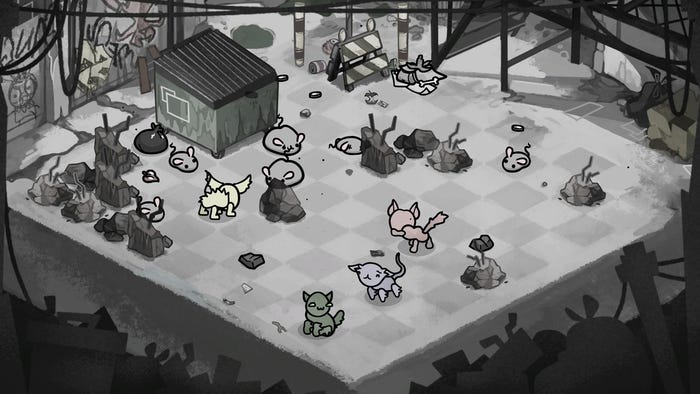Mod Mentality: How Tabletop Simulator was made to be broken
Indie devs (and former modders) Jason Henry and Kimiko chat with Gamasutra about why they developed an "online tabletop sandbox" game aimed explicitly at modders, and what they learned along the way.

When Tabletop Simulator graduated out of Early Access last month, it marked Berserk Games' debut as a bona fide game-shipping indie studio.
That was a big deal for studio cofounders Jason Henry and Kimiko, who got their start in game development as passionate Chivalry: Medieval Warfare modders before taking to Kickstarter with their pitch for this "online tabletop sandbox" game and raising more than ten times their $3k asking price.
But Tabletop Simulator is more than an indie Kickstarter success story -- it's also the nexus of some intriguing trends in contemporary game development.
Explicitly made by modders for modders, Tabletop Simulator is an example of how game designers may find success developing games aimed squarely at the modding community. Berserk shipped the game with a number of classic board games built in -- chess, checkers and the like.
But Tabletop Simulator is made to be broken apart, tinkered with and glued back together; many copies will be sold on the strength of its vibrant Steam Workshop lineup, which includes mods to add everything from tabletop RPGs to miniature golf courses into the game.
(However, many of the top titles are fan-mods of copyrighted board games and RPGs - potentially controversial, and something Berserk may gradually cover with official DLC, such as the newly released & officially-licensed Superfight card game.)
Tabletop Simulator also tackles the tricky problem of intuitively replicating the fine motor control capabilities of human hands in a virtual space, something a lot of VR game developers are struggling with. Gamasutra chief Kris Graft has written at length about the charm of seemingly mundane experiences like cooking and painting in VR; as developers seek to replicate an even broader swathe of human pastimes, they'll need to figure out how to design appropriately intuitive control schemes.
I've been thinking a lot about this stuff after corresponding briefly with Henry and Kimiko over email; I think game developers might benefit from hearing about what they learned in developing Tabletop Simulator, so I've reprinted an excerpt of our conversation below.
Let's talk about the design of Tabletop Simulator. How does it reflect Berserk's sensibilities as a game maker? What were your specific influences and inspirations?
With Tabletop Simulator being a sandbox, that is essentially the design itself. We implemented the different tools and mechanics to give the player the freedom to create any tabletop experience possible.
Desperate Gods was our biggest inspiration. It’s such a fun game and unique concept. We wanted to expand on the idea to work with any tabletop game. We’re actually surprised no one else decided to create it first!
We, Berserk Games, like open-ended sandbox games, and this is about as open-ended as it gets! The players can create just about anything, make up their own rules, and so much more.
What is it about open-ended games, specifically, that you as game makers find so exciting? What does it take to design a high-quality open-ended sandbox game, do you think?
In scripted games, there’s usually a path that you follow so it’s much more limited. Open-ended games give players more dynamic content to shape the game how they want. Players are able to dictate their own adventures!

Sandbox games are all about the tools. Well-designed and intuitive tools allow players to move the “sand” around to their desires. So it takes a lot of trial and error to come up with something feels natural.
Did you run into any particularly memorable problems while designing Tabletop Simulator?
The biggest thing was how to handle physics over multiplayer. The host runs all the physics on their machine, and all the connected clients are dummies that receive the position from the host using interpolation and exterpolation to smooth out the results for the client view. It does add a slight delay of latency to the physics to the clients but it’s the truly accurate way to simulate physics across the network due to the unreliable nature of physics.
Other things was coming up with a smart way to give people freedom without having actual hands.There are also a lot of controls, so trying to make the whole setup as un-clunky as possible.
So how did you figure out how to get around the problem of people not having actual hands in the game?
By coming up with a well-thought out, intuitive control scheme. And it’s one we’re still actively improving because there are so many different actions and game possibilities.
Fair enough! As virtual reality and augmented reality games become more commonplace, how will your approach to game development change? Do you see yourselves moving into VR/AR game design?
There are a lot of extra challenges that appear when targeting a VR/AR environment that don’t really become apparent until you try it out yourself.
That being said, we will definitely be pursuing VR/AR for Tabletop Simulator. VR/AR poses an interesting way to play digital tabletop games that could approach similarities with playing in real life.
Speaking of real life: Tell me a bit more about how you got into game development, and why.
Jason Henry: Like most people, I grew up living and breathing video games, but it was always something that seemed far-fetched to my family. At first I listened, went to college for engineering but was bored, so in my free time I got into modding and taught myself programming.
I learned how to program by modding for the game Chivalry: Medieval Warfare, creating Mana Warfare, a wizard mod that quickly got popular. Initially, I learned Unreal Script and even applied for a job at Torn Banner, the creators of Chivalry, but that didn’t pan out (haha).
So I decided to create my own game, Tabletop Simulator, and the rest is history.
Kimiko: I also grew up playing games and was a huge fan of Starcraft and its expansions. I was more into the creative side of things and taught myself web design, Photoshop, and Illustrator. I used to play the mod Age of Chivalry and was super excited when Chivalry: Medieval Warfare finally got released.
I was very invested in the game and ended up becoming a moderator on the forums. I put a lot of time into being a moderator and when GDC came around, I met up with the Torn Banner team and brought up the idea of becoming the Community Manager.
We discussed our terms and what I’d be doing and became an official member of the team. It was a great experience. I learned a lot and was able to experience shipping our first DLC: Deadliest Warrior.
What lessons did you learn from your time in the mod community, and how did you apply those lessons while developing your first original game?
The most important thing was not to give up when running into roadblocks, because you will run into a lot of those throughout development. The game industry is ever-changing, and so we continue to learn new skills along the way as well.

And of course we learned what it takes to actually release a product that everyone plays, not just a prototype for testing. This was a great experience all around.
About the Author(s)
You May Also Like









.png?width=300&auto=webp&quality=80&disable=upscale)



